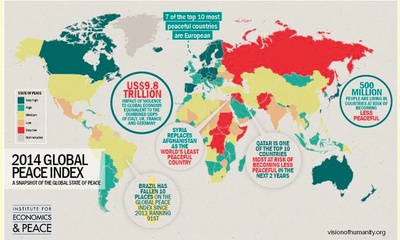|
|
Global Peace Index: The United States Isn't Even Among the World's 100 Most Peaceful Countries
un articulo por Matt Lemas, RTOT News + Action (abridged and reprinted by permission)
World peace is a goal constantly that governments, humanitarians,
average people, and beauty pageant contestants all strive to
achieve. But according to this year’s Global Peace
Index, Planet Earth is on the wrong track. 
2014 Global Peace Index
click on photo to enlarge
Since the study began in 2008, world peace has shown a trend of
“slight deterioration. The truth is, however, it hasn’t always been
like this. For the sixty years after World War II, world peace looked
like a real possibility. Only in the past decade has that trend been
broken.
So, what happened? Let’s take a look at some of the major conflicts
threatening world peace that have been sprouting up. There have
been two civil wars in Syria and Libya, a huge increase in Central
American drug violence, nonstop conflicts in the Middle East, and
social unrest in Somalia, The Democratic Republic of the Congo and
South Sudan — and that’s just to name a few. All that violence
doesn’t exactly foster peace.
To determine the peacefulness of 162 countries, the index uses 22
indicators, including the number of internal and external conflicts a
country’s involved in, their rates of violent crime, and how much
they spend on the military.
That data showed that world peace deteriorated over the last years,
thanks to a widespread rise in four of the 22 indicators: level of
terrorist activity, how many weapons they were importing and
exporting, and how many homicides were reported.
Not all the results, however, were so depressing — some countries
showed an increase in peace after the resolution of military conflicts
in Iraq and Afghanistan, plus a reduction in military spending due
to the European budget crisis.
Iceland topped the 2014 list as the most peaceful country in the
world, followed by Denmark, Austria, Switzerland and Finland. As a
whole, Europe was the most peaceful region.
Conversely, the most tumultuous nations on the list were in the
Middle East and Africa. Syria’s ongoing civil war meant it was
the least peaceful nation, followed by Afghanistan, South Sudan,
Iraq and Somalia.
South Sudan’s levels of peace went the most downhill in 2014
because of conflict between the government and rebel groups since
last December. Politics grew unstable, and many people had access
to guns. Egypt also dropped pretty far, falling 31 positions to 143
after the ousting of former president Mohamed Morsi.
Some more developed nations, like the United Kingdom and France,
ranked 47 and 48 respectively. Across the pond, numbers varied.
Canada ranked high as the 7th most peaceful nation, while Mexico
ranked 138th.
As the world’s only superpower, the United States didn’t do so hot
in the list — it placed as the 101st most peaceful nation, dropping
four spots from last year. This drop was attributed to the Boston
Marathon bombing, but as a whole, the report states
America’s score is dragged down by its high degree of
militarization, and because it has the highest incarceration rate in
the world.
Not surprisingly, a downgrade in peace doesn’t come without a
price. According to the index, the price tag of global violence
comes to $9.8 trillion in 2013 alone (wars aren’t cheap). That sum
comes out to roughly $1,350 per person. . .
[Thank you to Janet Hudgins, the CPNN reporter for this article].
|








|
DISCUSSION
Pregunta(s) relacionada(s) al artículo :
How can we know if the culture of peace is advancing?,
* * * * *
Comentario más reciente:
:
One way we can NOT know if the culture of peace is advancing is from projects like the Global Peace Index which has recently been reviewed in CPNN.
The Global Peace Index measures the old dimensions of war and peace, not the new dimensions of culture or war / culture of peace. Peace, in the old paradigm was the period between wars when countries were preparing themselves for the next war. Culture of Peace, the new paradigm, is concerned with the deep roots of war, its cultural basis.
That can explain the paradox that it is the wealthy countries of the North that score highest on the index (Denmark, Austria, Switzerland and Finland), countries of Europe, which was involved in both the World Wars and which continue to profit from the unequal terms of trade between North and South which is enforced by the culture of war.
When I was at UNESCO, the African ambassadors had the following to say: "One should not look to the South for the causes of the culture of war; instead, pose three questions. From where do the weapons come? From where do the violent television programmes come? And where are the terms of trade decided that impoverish the people of the South which leads to violence? "

|
|









